The Samsung LN55A950 has a pair of integrated 15W
speakers that are a step up from the 10W speakers that have shipped on previous
Samsung LCD HDTVs. While the 10W speakers found on the Samsung 6
series and 8 series were suitable for watching broadcast television, when it
came to music or movies the overall sound was tinny, with no real bass to speak
of. Moving from 10W to 15W doesn't seem like it would make a big change, but
Samsung has also re-designed the speakers for their 9 series of televisions, taking advantage of the LN55A950's wider
profile to fit in a larger speaker and sub-woofer assembly.
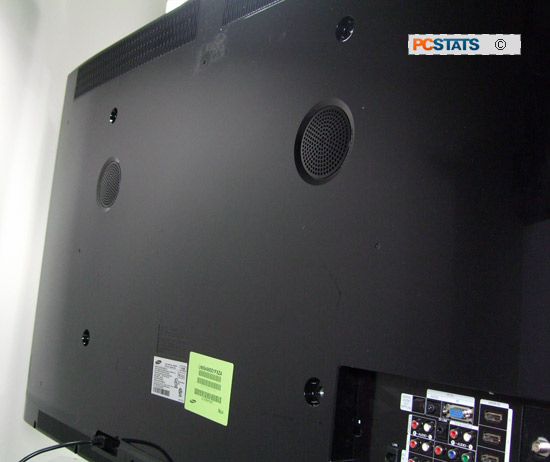
The result is a night and day difference in sound quality. The additional
bass makes a big difference during the explosions, roars and crunches that make
action scenes so exciting, and the additional frequency range brings makes it
easier to pick out individual instruments when music is playing. The sound
is good enough that you could very well get away without a home-theatre speaker
setup.
Viewing Experience:
LED backlighting make a difference?
The Samsung LN55A950 uses an active LED matrix as a backlight. LED
backlighting works by dividing the TV into an array into small zones which can
be switched off where dark images are shown, selectively dimming the LEDs.
|
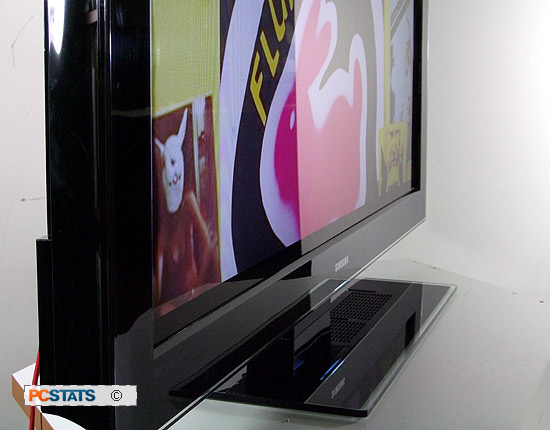
The Samsung LN55A950 has overall viewing
angles of 178º/178º, so its overall brightness and colour remain
visible even when viewed from the sides. The screen has
a glossy reflective coating, which can cause some glare in
well-lit rooms.
|
This is also what gives the Samsung LN55A950 its
unbelievable 2,000,000:1 dynamic contrast ratio. LED backlighting can also
reduce motion blur and illumination smearing by cycling individual rows of LEDs
at speeds of 1/8th of a second, creating a sharper, clearer image.
Unlike traditional CCFL backlighting, LED backlighting can be dimmed locally
or turned off altogether when it's not needed. This eliminates the light
leakage and 'panel glow' that CCFL backlighting produces, so that LED backlit
displays can have black levels that are dramatically darker, approaching pure
black
Of course being the kind of gadget nerds we are over here at PCSTATS,
we can't let any new tech pass through our labs untested. As soon as the
Samsung LN55A950 came into our offices it was placed on the test bench.
To compare the viewing experience on the Samsung
LN55A950, we pit it directly against its older brother, the Samsung
LN52A850.
The 52-inch 8-series television
uses a Cold Cathode Flourescent Lamp (CCFL) backlight, like most other LCD
televisions on the market. We placed the two HDTVs side by side, and hooked them
both up to a home theatre PC via HDMI.
We set the HTPC to output 1920x1080 resolution at 60hz
and 32bit colour, adjusted both HDTVs to equal brightness and contrast levels, and dimmed the lights. PCSTATS benchmarking started with PassMark Monitor test,
a monitor calibration and testing suite designed to stress the performance of
screens and highlight the differences between different displays. Initial tests confirmed
that the black levels on the Samsung LN55A950 television were indeed far
deeper than that of the Samsung LN52A850.
|
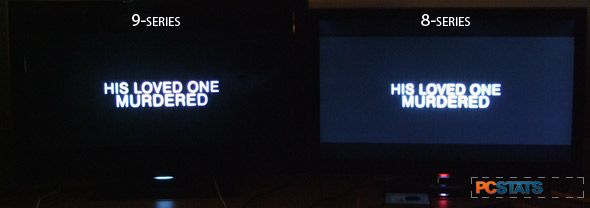
Both Samsung HDTVs were placed
side by side so the camera could capture both displays in a single frame.
The black levels of the 9-series television are indistinguishable from the
black bezel surrounding the screen.
|
The Samsung 8-series television's CCFL backlight showed visible
illumination in areas that were supposed to be black. The backlight was capable
of dark greys, which under normal lighting look like black. However once the
lights are dimmed the contrast between what the screen displays as black and the
actual black of the LN52A850's bezel becomes obvious.
The LN55A950's LED local dimming produces
black levels so deep that in a dark room it's nearly
impossible to differentiate between the darkness of the screen and the black bezel
around it. This makes the viewing experience noticeably more immersive, since there's less to
break the illusion and remind you that you're staring at a screen.
There do appear to be some quirks to LED backlighting as you can see
in the picture below.
|
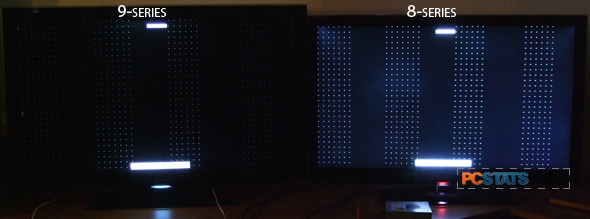
The white strips at the top and
bottom of the screens are Passmark's on-screen display for the dot
convergence test.
|
This is Passmark's dot convergence test, and it shows how the CCFL
and LED screens function very clearly. The dot test convergence pattern
spaces dots about one inch apart in a grid, spaced evenly with large black
columns in between them. Typically it's used to test color imperfections and
misalignment with older CRT monitors.
|
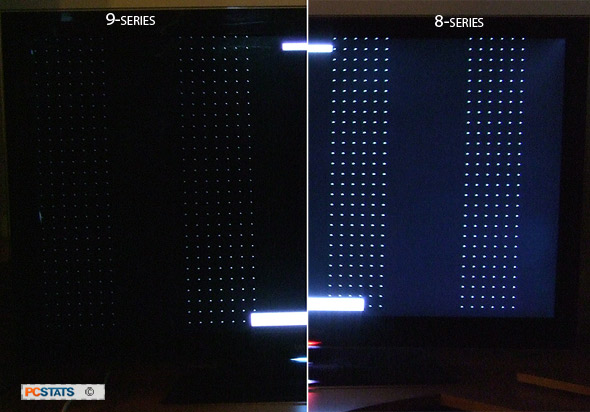
Both sides of
this closeup have been zoomed in from the previous
picture, so both HDTVS have been captured at the same
exposure. Notice how on the 9-series HDTV the dots fade
away the further they get from the bright menu bars, while
the 8-series has consistent lighting from edge to edge.
|
However in this case the 8-series CCFL shows the dots lit up evenly
across the surface of the television, with each column of dots clearly visible
from top to bottom. The Samsung LN55A950's 9-series locally-dimmed LED backlight
can't quite accommodate this type of picture, because the dots are not grouped
together in large bright areas. The white dots that are closer to the menu
bars on the top and bottom of the screen get a bright white illumination
while the dots that are further to the extremes of the screen are generally
dimmer. Whatever algorithm Samsung uses to determine when the LED
backlights should be turned on is unable to cope with this test pattern, so the
predominant black takes precedence over the individual points of light.
More on this right
after the jump, this time with high definition video clips...
